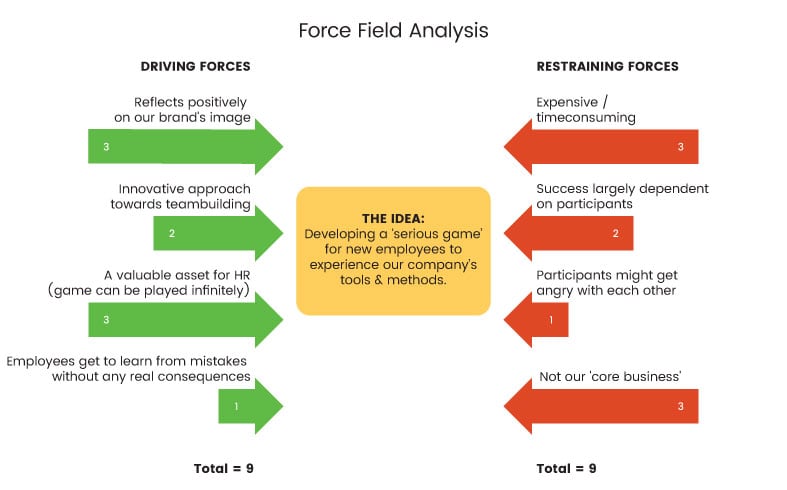Force Field Analysis
It’s not always wise to pursue a creative idea. Even if an idea sounds great, there might be good reasons to abstain from action. That’s why most creative ideas will face a ‘Go/No-go’ moment. The stage in which the decision is made to either continue or quit a project. Needless to say, pros and cons can sometimes be quite difficult to compare. Making it feel like comparing apples to oranges. So, how do you make a well-informed decision? One way to do so is by using Force Field Analysis.
Force Field Analysis – How does it work?
Step 1. Describe your desired outcome
Grab a large piece of paper. In the centre, write down your idea and what you want to achieve with it.
Example
Developing a ‘serious game’ for new employees to experience our company’s tools & methods.
Step 2. Note all driving forces
Note on the left side of your idea all the (internal and external) factors that contribute towards the realisation of your goal.
Example
– Developing a game is good for our brand’s image (being seen as a creative company)
– Employees can learn from their mistakes in a safe environment (low-risk learning)
– To experience by yourself is the best way to learn something (powerful tool for HR)
– You make the game once, and then you can play it an infinite number of times (asset for HR)
– A game is great for teambuilding
Basically; what would the supporters of this idea say?
Step 3. Note all restraining forces
Note on the right side of your idea all the arguments which can be made against pursuing this idea.
Example
– Developing a game is expensive (€)
– Developing a game is time-consuming
– It’s not our core business to develop games
– The success of the game depends on the commitment of the players
– Some employees might find a game childish
Basically; what would opponents of this idea say?
Step 4. Assign scores
Study all positive and negative factors, and give each of them individually a score between 1 (weak) and 5 (strong). Visualise the strength of the score by drawing arrows. Use big arrows for a strong force and small arrows for weak forces.
Try not to let your own preferences influence the scores. For each factor, imagine how big of a deal this is for those involved (and how much influence these people have).
Next, put the total score for each column at the bottom of the page.

Step 5. Analyse
Take a step back and look at the bigger picture. Is there a balance between the positive and negative forces? Are there a lot or a few driving/restraining forces? Are these weak or strong? Does something particularly strike you?
Being confronted with a large list of negative forces can be quite demotivating. That’s why you should always start with the positives.
Decide alone or with your team whether to continue exploring the idea. Is everybody still enthusiastic despite the identified resistance? Great, then proceed to the next step.
Step 6. Improve
Now that you have mapped out all important forces, it’s time to create a preferable plan. Brainstorm with your team about new ideas to strengthen the positive factors and to reduce the negative factors.
Driving Forces
Which positive forces are weak? How can you strengthen them? Which factors are strong? In what other ways can you utilise them?
Restraining Forces
Which restraining forces are strong? How can you take them away? If removing them altogether isn’t an option, how can you reduce their force?
If you enjoyed reading this article, these posts might interest you as well:





